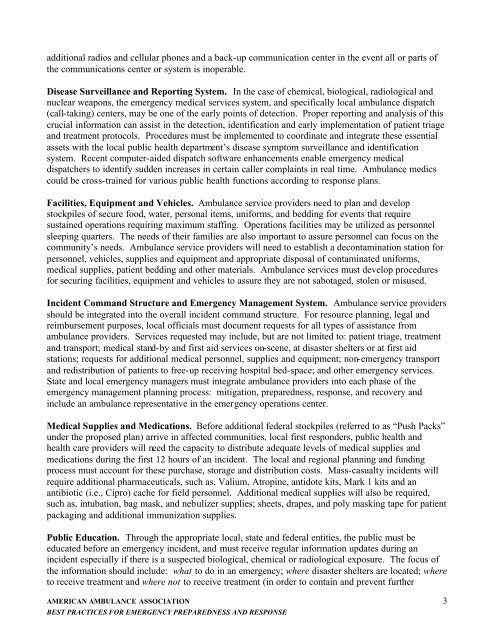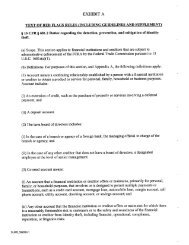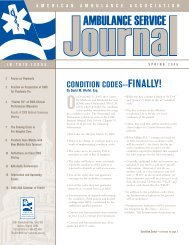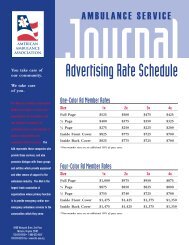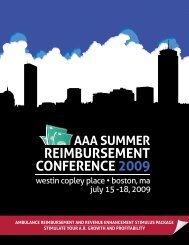Best Practices - Website - American Ambulance Association
Best Practices - Website - American Ambulance Association
Best Practices - Website - American Ambulance Association
Create successful ePaper yourself
Turn your PDF publications into a flip-book with our unique Google optimized e-Paper software.
additional radios and cellular phones and a back-up communication center in the event all or parts ofthe communications center or system is inoperable.Disease Surveillance and Reporting System. In the case of chemical, biological, radiological andnuclear weapons, the emergency medical services system, and specifically local ambulance dispatch(call-taking) centers, may be one of the early points of detection. Proper reporting and analysis of thiscrucial information can assist in the detection, identification and early implementation of patient triageand treatment protocols. Procedures must be implemented to coordinate and integrate these essentialassets with the local public health department’s disease symptom surveillance and identificationsystem. Recent computer-aided dispatch software enhancements enable emergency medicaldispatchers to identify sudden increases in certain caller complaints in real time. <strong>Ambulance</strong> medicscould be cross-trained for various public health functions according to response plans.Facilities, Equipment and Vehicles. <strong>Ambulance</strong> service providers need to plan and developstockpiles of secure food, water, personal items, uniforms, and bedding for events that requiresustained operations requiring maximum staffing. Operations facilities may be utilized as personnelsleeping quarters. The needs of their families are also important to assure personnel can focus on thecommunity’s needs. <strong>Ambulance</strong> service providers will need to establish a decontamination station forpersonnel, vehicles, supplies and equipment and appropriate disposal of contaminated uniforms,medical supplies, patient bedding and other materials. <strong>Ambulance</strong> services must develop proceduresfor securing facilities, equipment and vehicles to assure they are not sabotaged, stolen or misused.Incident Command Structure and Emergency Management System. <strong>Ambulance</strong> service providersshould be integrated into the overall incident command structure. For resource planning, legal andreimbursement purposes, local officials must document requests for all types of assistance fromambulance providers. Services requested may include, but are not limited to: patient triage, treatmentand transport; medical stand-by and first aid services on-scene, at disaster shelters or at first aidstations; requests for additional medical personnel, supplies and equipment; non-emergency transportand redistribution of patients to free-up receiving hospital bed-space; and other emergency services.State and local emergency managers must integrate ambulance providers into each phase of theemergency management planning process: mitigation, preparedness, response, and recovery andinclude an ambulance representative in the emergency operations center.Medical Supplies and Medications. Before additional federal stockpiles (referred to as “Push Packs”under the proposed plan) arrive in affected communities, local first responders, public health andhealth care providers will need the capacity to distribute adequate levels of medical supplies andmedications during the first 12 hours of an incident. The local and regional planning and fundingprocess must account for these purchase, storage and distribution costs. Mass-casualty incidents willrequire additional pharmaceuticals, such as, Valium, Atropine, antidote kits, Mark 1 kits and anantibiotic (i.e., Cipro) cache for field personnel. Additional medical supplies will also be required,such as, intubation, bag mask, and nebulizer supplies; sheets, drapes, and poly masking tape for patientpackaging and additional immunization supplies.Public Education. Through the appropriate local, state and federal entities, the public must beeducated before an emergency incident, and must receive regular information updates during anincident especially if there is a suspected biological, chemical or radiological exposure. The focus ofthe information should include: what to do in an emergency; where disaster shelters are located; whereto receive treatment and where not to receive treatment (in order to contain and prevent furtherAMERICAN AMBULANCE ASSOCIATION 3BEST PRACTICES FOR EMERGENCY PREPAREDNESS AND RESPONSE


